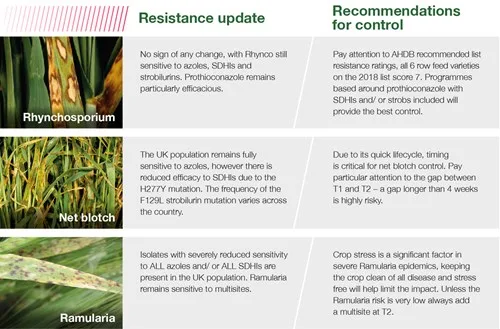

SiltraXpro
When you want to push your barley crop to the limit for yield and quality premiums, SiltraXpro is the fungicide of choice.
Product details

When to use SiltraXpro
SiltraXpro can be used at both T1 and T2 in winter and spring barley crops, or makes a perfect programme partner for Fandango (prothioconazole + fluoxastrobin). When using as a split programme then Siltraxprodelivers most for your crop at T1 in winter barley and T2 in spring barley.
How to use SiltraXpro
SiltraXpro In Winter Barley:
T1 (GS 29-31) - 0.6 - 0.8 L/ha SiltraXpro + 500 g/ha CTL for control of all major barley diseases particularly on higher yielding potential crops and where disease pressure is elevated. In winter barley this is the most responsive time for fungicide applications as final yield is driven by tiller survival so if you only plan to use Siltraxpro once in your programme this is the timing to do so.
T2 - 0.4 - 0.6 L/ha SiltraXpro + 500 g/ha CTL in high yield potential situations, or if you are faced with high late season disease pressure, especially net blotch or Ramularia. Consider the higher rate in Scotland where the period of green canopy is extended.
Siltraxpro In Spring Barley:
T1 - 0.4 L/ha SiltraXpro + 500 g/ha CTL in high yield potential situations where soil moisture is less of a limiting factor, soils are particularly fertile or where early season disease pressure is high.
T2 - 0.4 - 0.8 L/ha SiltraXpro + 500 g/ha CTL for higher yielding crops or where late season disease pressure is high. Use higher rates for high pressure Ramularia sites where the growing season is extended eg Scotland.
It combines the best azole for barley disease control, prothioconazole, with new generation SDHI bixafen to form the new standard for Rhynchosporium, net blotch, brown rust and Ramularia control. Since its introduction SiltraXpro has set the standard for barley disease control, with AHDB fungicide performance trials consistently showing that SiltraXpro gives the best control against all barley diseases.
A dramatic shift in the sensitivity of Ramularia leaf spot fungus to leading fungicide chemistry means barley growers must take extra care with spray timings and product selection.
Bayer identified two mutations, one causing resistance to the SDHI fungicide group while a second target site mutation significantly reduced azole activity. Ramularia resistance to strobilurins has previously been confirmed, so three major fungicide groups now offer limited control in winter and spring barley where resistance is present.
Anyone growing barley should assume Ramularia is a threat which cannot be fully controlled with SDHI, triazole or strobilurin-based chemistry alone.
No resistance has been found to the broad spectrum fungicide chlorothalonil, so this is essential for controlling Ramularia. T2 is the key timing.
Although the dramatic resistance development presents challenges for Ramularia control, sensitive populations are still present in the UK, so not all crops will be affected.
Products like SiltraXpro remain effective where there is no resistance, although should be used with CTL for resistance management.
Even trials under very high disease pressure last year in Suffolk found a two-spray programme of SiltraXpro without CTL still delivered 50-60% Ramularia control, although by adding CTL this increased to 90%. Bixafen also aids greening, which improves crop health, he adds.
Siltra Xpro has been the best product in AHDB fungicide performance trials from 2009 - 2018. In these trials, Siltra has been shown to deliver a 0.2 t/ha yield increase over Elatus ERA.
The superior formulation of Siltra leads to increased spread ability and quicker drying times, as demonstrated in the below visual comparing Siltra Xpro and Elatus ERA.
